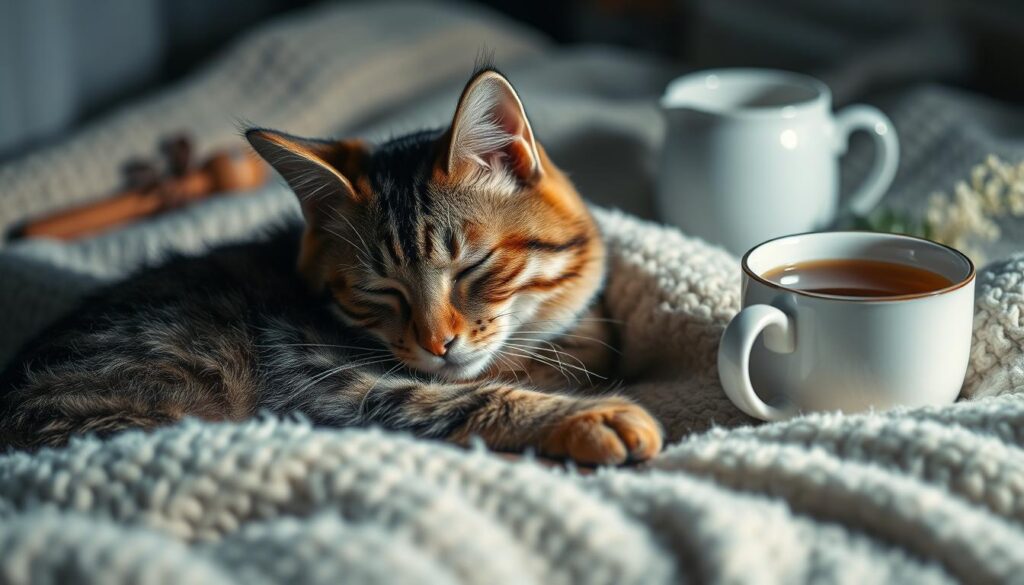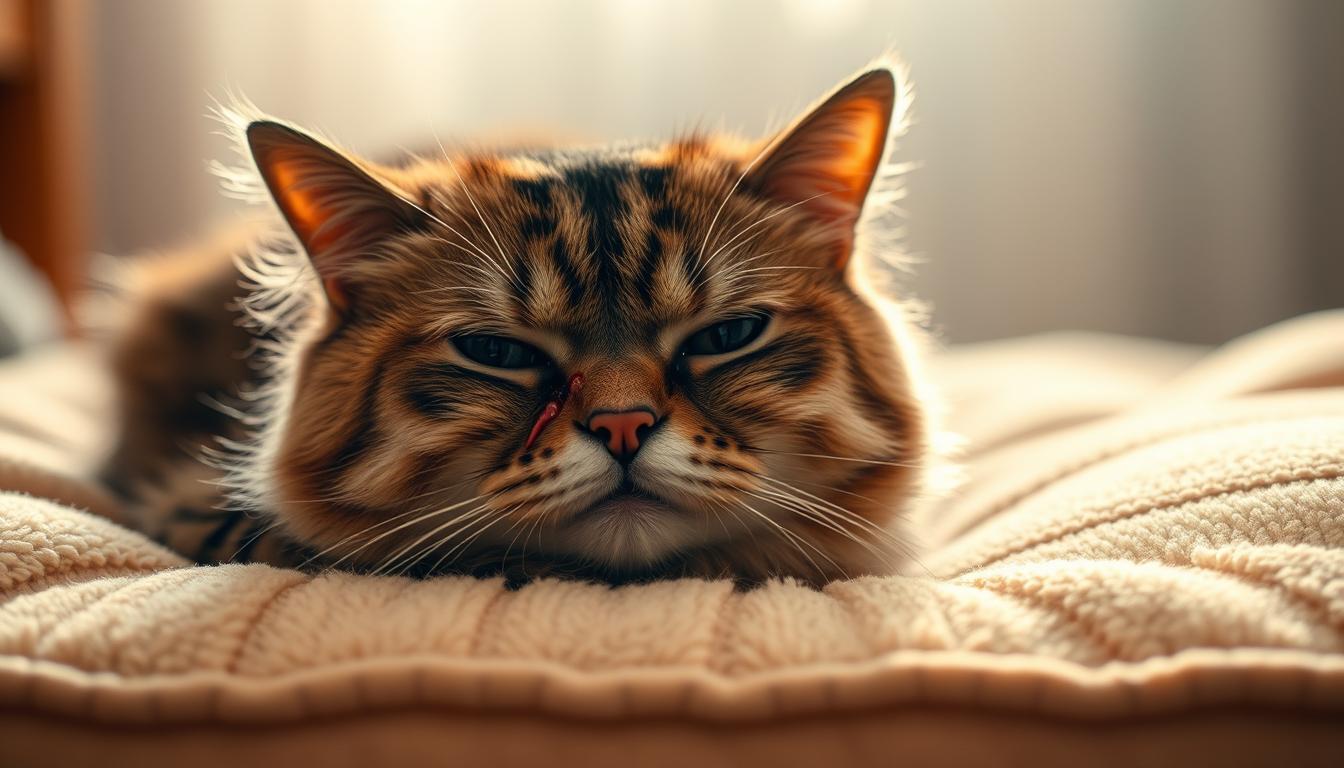Can Cats Get Colds
Can Cats Get Colds: As a cat owner, you’ve probably noticed how your pet communicates. They use body language and subtle behaviors to show how they’re feeling. Paying attention to these changes can be crucial in spotting health issues early.
Cats can get upper respiratory infections, similar to human colds. They might sneeze, have runny eyes, or seem tired. It’s important to understand these health issues to care for your cat properly.
Can Cats Get Colds:Knowing the signs and how to help can make your cat’s recovery easier. In this article, we’ll look at surprising facts about cat colds. We’ll also talk about how you can support your pet’s health.
Key Takeaways
- Understanding cat body language is crucial for identifying health issues.
- Cats exhibit cold-like symptoms when they have upper respiratory infections.
- Early detection of symptoms can lead to better care for your cat.
- There are specific ways to help your cat recover from a cold.
- Recognizing the signs of cat colds can improve your pet’s comfort and recovery.
Understanding Feline Upper Respiratory Infections
Upper respiratory infections in cats are a big worry for cat owners. They can cause serious health problems if not treated right. These infections are caused by viruses and bacteria that affect the cat’s breathing system.
What Causes Cat Colds
Can Cats Get Colds:Cat colds, or feline upper respiratory infections, are mainly caused by viruses and bacteria. The most common culprits are feline herpesvirus and feline calicivirus. These are very contagious and spread easily among cats.
Common Viruses and Bacteria
Viruses: Feline herpesvirus (FHV-1) and feline calicivirus (FCV) are the top viral causes. Bacteria: Bordetella bronchiseptica and Chlamydophila felis are common bacterial causes. These pathogens can cause symptoms from mild sneezing and discharge to severe pneumonia.
| Pathogen | Type | Common Symptoms |
|---|---|---|
| Feline Herpesvirus (FHV-1) | Virus | Sneezing, nasal discharge, conjunctivitis |
| Feline Calicivirus (FCV) | Virus | Oral ulcers, sneezing, limping |
| Bordetella bronchiseptica | Bacteria | Coughing, sneezing, pneumonia |
| Chlamydophila felis | Bacteria | Conjunctivitis, sneezing, mild upper respiratory symptoms |
How Cat Respiratory Systems Work
Can Cats Get Colds:The feline respiratory system is made to efficiently exchange oxygen and carbon dioxide. But when infected, it can get damaged. This leads to symptoms of upper respiratory infections. Knowing how these infections affect the respiratory system is key to proper care.
Can Cats Get Colds? The Surprising Answer
Can Cats Get Colds:Cat owners often wonder if their pets can catch colds. The answer might surprise you. Cat colds are caused by different pathogens than human colds.
How Cat Colds Differ from Human Colds
Feline upper respiratory infections, or “cat colds,” are caused by viruses and bacteria specific to cats. The main culprits are herpesvirus and calicivirus. Unlike human colds, which are usually caused by rhinoviruses, cat colds have different causes.
It’s important to understand these differences to provide the right care. Humans might get a sore throat or a runny nose. Cats, on the other hand, often sneeze, have eye discharge, and feel tired.
Transmission Between Cats
Can Cats Get Colds: Cat colds spread easily among cats. They can catch it by touching an infected cat’s saliva, mucus, or feces. Multi-cat households are especially at risk because the virus can spread quickly.
Outdoor cats or those that meet other cats, like in shelters, are also at high risk. They can catch and spread the infection.
The Science Behind Feline Respiratory Infections
Can Cats Get Colds:The science behind feline respiratory infections involves understanding the viruses and bacteria. Feline herpesvirus is a common cause of upper respiratory infections in cats. Once infected, cats can carry the virus and have outbreaks.
Research on feline respiratory infections is ongoing. Veterinarians and scientists are working to find better treatments and ways to prevent these infections.
5 Surprising Facts About Cat Colds You Need to Know
As a cat owner, you might know about sneezing fits or runny noses. But there’s more to learn about cat colds. Knowing these facts helps you care for your cat better.
Cats Can’t Catch Colds from Humans
Can Cats Get Colds: One surprising fact is that cats can’t catch colds from humans. Feline upper respiratory infections come from viruses and bacteria that only affect cats. So, you don’t have to worry about giving your cat your cold.
Some Cats Are More Susceptible Than Others
Just like humans, some cats are more likely to get colds. Age, health, and lifestyle can affect a cat’s risk. Kittens and older cats are often more at risk because their immune systems are weaker.
Cat Colds Can Lead to Serious Complications
Can Cats Get Colds: While cat colds are usually mild, they can sometimes cause serious problems. These include pneumonia or bronchitis. If your cat’s symptoms get worse, it’s crucial to get vet care to avoid these issues.
Stress Can Trigger Cold Symptoms
Stress can make cats more likely to get colds. Changes like a new pet or person in the home can stress your cat. This stress can weaken their immune system and make them more prone to illness.
Cat Colds Can Be Seasonal
Can Cats Get Colds: Cat colds, like human ones, can follow a seasonal pattern. Winter or when cats spend more time indoors can raise the risk of infections.
Learning about cat colds helps you keep your cat healthy and happy. If you’re worried about your cat’s symptoms or health, always talk to your vet for advice.
Recognizing Cat Cold Symptoms
Can Cats Get Colds: It’s important to know the signs of a cat cold to treat them right. As a cat owner, knowing the common signs of illness is key.
Common Signs Your Cat Has a Cold
Can Cats Get Colds: Cats show different symptoms when they have a cold. These include:
- Lethargy: A decrease in energy, making them less active.
- Changes in Appetite: A change in how much they eat can be a sign of illness.
- Sneezing and Congestion: Frequent sneezing and nasal discharge are common cold signs.
- Watery Eyes: Red, watery, or discharge-filled eyes can signal a cold.
Differentiating Between Allergies and Colds
It’s hard to tell between allergies and colds in cats. Allergies tend to cause more itching and skin issues. Colds usually have more respiratory symptoms.
Tracking Symptom Progression
Watching your cat’s symptoms is key to understanding their health.
Early Warning Signs
Early signs of a cat cold may include:
- Mild sneezing
- Slight nasal discharge
- Mild lethargy
Advanced Symptoms
If not treated, cat colds can get worse. Symptoms can include:
- Persistent sneezing
- Thick, yellow or green nasal discharge
- Increased lethargy
- Loss of appetite
Knowing these signs and tracking them can help you care for your cat. It also helps you know when to see a vet.
The Most Common Causes of Feline Respiratory Infections
Can Cats Get Colds: Knowing what causes feline respiratory infections is key to keeping your cat healthy. Cat colds, or feline upper respiratory infections, can come from viruses, bacteria, and environmental factors.
Viral infections are a main reason for these infections. The main culprits are feline herpesvirus and feline calicivirus. These viruses spread easily through contact with an infected cat’s saliva or mucus.
Viral Causes: Herpesvirus and Calicivirus
Feline herpesvirus (FHV) and feline calicivirus (FCV) are the top viruses. FHV can lead to serious eye problems, while FCV causes mouth sores and breathing issues.
Bacterial Infections: Bordetella and Chlamydia
Bacteria like Bordetella bronchiseptica and Chlamydia felis can also cause infections. These can range from mild to severe and often follow a viral infection.
Environmental Factors That Increase Risk
Can Cats Get Colds: Things like stress, bad air, and smoke can make cats more likely to get sick. Fido Fave says these factors are big risks for cats.
Multi-Cat Household Considerations
Living with many cats raises the risk of passing infections. Keeping things clean, reducing stress, and vaccinating can help lower this risk.
| Cause | Description | Prevention |
|---|---|---|
| Viral Infections | Feline herpesvirus and calicivirus | Vaccination |
| Bacterial Infections | Bordetella and Chlamydia | Antibiotics, hygiene |
| Environmental Factors | Stress, poor ventilation | Reduce stress, improve ventilation |
By knowing these causes, you can take steps to keep your cat healthy and lower the risk of respiratory infections.
When to Be Concerned: Warning Signs That Require Veterinary Care
Can Cats Get Colds: As a cat owner, knowing when to get vet help is key. Most cat colds are not serious, but some need quick action. This is to avoid bigger problems or to treat hidden issues.
Severe Symptoms That Shouldn’t Be Ignored
Can Cats Get Colds: Watch your cat closely for bad signs. Look out for trouble breathing, eye or nose discharge, or a big drop in appetite. If you see these, call your vet. Quick action can really help your cat get better.
Complications from Untreated Colds
Ignoring a cat cold can lead to big problems. These include pneumonia or long-term breathing issues. If your cat’s cold gets worse or doesn’t get better, see a vet. They can check for these serious issues.

Emergency Situations: When to Seek Immediate Help
Some times, your cat needs help right away. Look out for severe lethargy, fast breathing, or not wanting to drink. These are signs of serious problems that need fast treatment, like treating a cat cold well.
How Veterinarians Diagnose Cat Colds
Vets use physical exams and tests to find cat colds. Finding cat colds is tricky because symptoms can look like other health issues.
Examination Process
Can Cats Get Colds: The first step is a detailed physical check-up. Your vet will look for signs of sickness in cats like sneezing and runny eyes. They also check for signs of other infections, like trouble breathing.
Tests Your Vet Might Perform
Your vet might do several tests to find the cause. They might take a swab from your cat’s nose or eyes. Blood tests or X-rays could also be needed to check for other problems.
Ruling Out Other Conditions
It’s important to tell a cold from other infections. Your vet will look at your cat’s health history and if they’ve been around other cats. Fido Fave says getting the right diagnosis is crucial for your cat’s care.
Knowing what’s causing your cat’s cold helps your vet create a good treatment plan. This helps your cat get better and stops the cold from spreading to other cats.
Treatment Options for Cat Colds
When your cat gets a cold, knowing how to treat it is key. Cat colds, or upper respiratory infections, can be caused by viruses or bacteria. The right treatment depends on the cause.
Medications Your Vet Might Prescribe
Vets often give meds to help manage cat cold symptoms. They also treat any secondary infections.
Antibiotics for Secondary Infections
If your cat gets a secondary bacterial infection, your vet might give antibiotics. It’s important to follow the vet’s instructions for these meds.
Antiviral Medications
In some cases, antiviral medications are given to fight viral infections. These are helpful for cats with severe symptoms or at risk of complications.
Supportive Care Techniques
Supportive care is key in treating cat colds. It makes your cat more comfortable and helps them recover.
- Keep your cat in a warm, stress-free place.
- Make sure they have plenty of fresh water.
- Use a humidifier to help with congestion.
Recovery Timeline and What to Expect
The time it takes for a cat to recover from a cold varies. It usually takes 7-10 days with proper care. But, watch your cat’s symptoms closely and get vet advice if they get worse or don’t get better.
By understanding treatment options and working with your vet, you can help your cat get better. This reduces the chance of complications.
Home Remedies and Care for Cats with Colds
Can Cats Get Colds: If your cat is sneezing or showing cold symptoms, there are ways to help. You can use home remedies and care strategies to make them feel better. It’s important to understand their needs and create a recovery-friendly environment.
Creating a Comfortable Recovery Environment
When your cat is sick, their comfort is key. Make sure their bedding is clean and comfy. Offer a warm, draft-free spot for them to rest.
You can also use a heated cat bed or a warm blanket to keep them cozy.

Nutrition and Hydration Tips for Sick Cats
Nutrition and hydration are vital for your cat’s recovery. Try to get them to eat by using their favorite foods. Warming their meals slightly can make them more appealing.
Make sure they always have fresh water. Some cats like running water, so a water fountain might encourage them to drink more. Adding a bit of low-sodium chicken broth to their food can also make mealtime more fun.
Safe Home Treatments to Ease Symptoms
Can Cats Get Colds: There are safe home treatments for your cat’s cold symptoms. These include:
Humidifiers and Steam Therapy
Humidifiers can help by adding moisture to the air. Running a hot shower and sitting with your cat in the bathroom can also create a steamy environment.
Gentle Cleaning Techniques
Gently cleaning your cat’s eyes and nose with a damp cloth can help. This removes discharge and makes them more comfortable. Use a clean section of the cloth for each eye to avoid infection.
| Symptom | Home Remedy |
|---|---|
| Congestion | Humidifier or Steam Therapy |
| Discharge | Gentle Cleaning with a Damp Cloth |
| Loss of Appetite | Warm, Appetizing Meals |
By using these home remedies and care strategies, you can help your cat recover from their cold more comfortably.
Preventing Cat Colds: Vaccination and Environmental Management
Can Cats Get Colds: Cat colds can be prevented by vaccination, reducing exposure, and keeping a clean environment. Understanding these steps can help lower your cat’s cold risk.
Vaccination Schedule and Options
Vaccination is key in stopping feline upper respiratory infections. Your vet will suggest the best vaccination schedule for your cat. They consider your cat’s age, health, and lifestyle. Core vaccines, like feline herpesvirus and feline calicivirus, protect against common cold causes.
Reducing Exposure Risk
It’s important to limit your cat’s contact with unvaccinated cats or strays. Keep their environment clean to avoid pathogens. Regularly clean food and water bowls, litter boxes, and other areas your cat touches.
Strengthening Your Cat’s Immune System
A healthy diet and lifestyle boost your cat’s immune system. Make sure they eat a balanced diet with all necessary nutrients. Your vet might suggest supplements.
Quarantine Procedures for New Cats
Quarantine new cats to prevent infection spread. This is crucial if you’re unsure of their health or vaccination history. Talk to your vet about the best quarantine steps.
Chronic Upper Respiratory Issues in Cats
Can Cats Get Colds: When cat colds don’t go away, they can turn into long-term health problems. These issues can really affect a cat’s life quality. But, with the right steps, you can make your cat feel better.
When Cold Symptoms Persist
If your cat’s cold symptoms don’t get better, see a vet right away. They can check for other health problems that might be causing the symptoms. Long-lasting colds can be a sign of something serious like cat flu.
Some signs that your cat’s cold is not going away include:
- Prolonged sneezing and nasal discharge
- Redness and inflammation of the eyes
- Lack of appetite or lethargy
Managing Cats with Recurring Respiratory Problems
Dealing with cats that keep getting sick requires a few steps. This includes medicine, changing their lifestyle, and making their environment better. Your vet might give them antibiotics or antiviral meds to help.
| Management Strategy | Description |
|---|---|
| Medication | Antibiotics or antivirals to manage symptoms |
| Lifestyle Changes | Reducing stress, improving diet, and ensuring adequate hydration |
| Environmental Adjustments | Improving ventilation, reducing exposure to irritants |
Long-term Care Strategies
For cats with long-term respiratory problems, regular vet visits are key. Keeping them healthy and watching for sickness signs is important. Good care can really improve their life.
“The key to managing chronic upper respiratory issues in cats is a combination of proper veterinary care, lifestyle adjustments, and a commitment to monitoring your cat’s health.”
Quality of Life Considerations
Can Cats Get Colds:When dealing with long-term respiratory issues, think about your cat’s happiness and comfort. Make sure they can do normal things and are happy. Keeping an eye on their health and adjusting their care as needed is very important.
Conclusion: Keeping Your Feline Friend Healthy
As a cat owner, it’s key to watch your pet’s health closely. Spotting signs of common cat illnesses, like cat colds, early can greatly help their recovery. Cat colds, or upper respiratory infections, are common in cats. Knowing how to treat cat cold symptoms is crucial for their care.
To help your cat get better from a cold, make sure they’re comfortable. Give them the right food and water, and follow your vet’s advice. Regular vet visits and a clean, stress-free home can also prevent illnesses. By staying informed and proactive, you can keep your cat healthy and happy.
Fido Fave stresses the need to know your cat’s health and act fast if you see any illness signs. This way, you can avoid serious problems and make sure your cat gets the care they need to do well.

